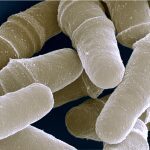Link to Pubmed [PMID] – 36629411
Link to HAL – Click here
Link to DOI – 10.1128/mmbr.00008-21
Microbiol Mol Biol Rev 2023 Mar; 87(1): e0000821
Schizosaccharomyces pombe is an ascomycete fungus that divides by medial fission; it is thus commonly referred to as fission yeast, as opposed to the distantly related budding yeast Saccharomyces cerevisiae. The reproductive lifestyle of S. pombe relies on an efficient genetic sex determination system generating a 1:1 sex ratio and using alternating haploid/diploid phases in response to environmental conditions. In this review, we address how one haploid cell manages to generate two sister cells with opposite mating types, a prerequisite to conjugation and meiosis. This mating-type switching process depends on two highly efficient consecutive asymmetric cell divisions that rely on DNA replication, repair, and recombination as well as the structure and components of heterochromatin. We pay special attention to the intimate interplay between the genetic and epigenetic partners involved in this process to underscore the importance of basic research and its profound implication for a better understanding of chromatin biology.


